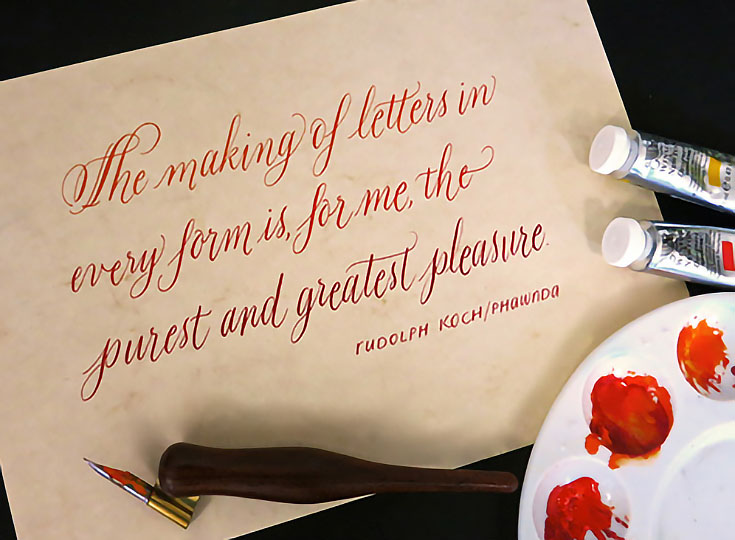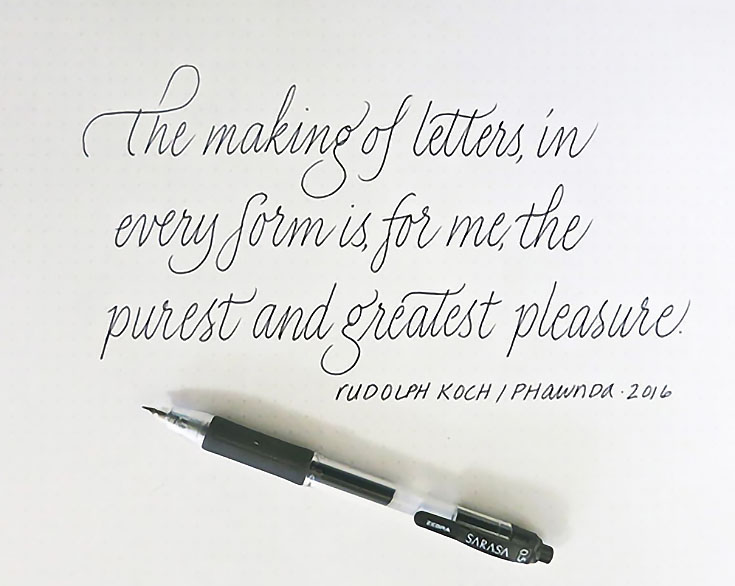Calligraphy students often ask if taking my class will improve their handwriting. Equally popular is the lament of parents or teachers, especially if they home school or their child is no longer learning handwriting in school.
Less than half of U.S. elementary schools now require handwriting instruction. Interestingly enough, when the Washington Post asked Americans if they felt handwriting was still relevant in a digital age, an impressive 82% responded “yes.”
There’s hope on the horizon! January 23 is National Handwriting Day (that day was John Hancock’s birthday) and the majority vows to keep it alive, one way or another. Some personally show support by sending handwritten notes; others mentor youngsters, an afternoon or two a week. Good for them!
Today, let’s revisit handwriting to see how you can improve yours and even make it an art form. . .
Referencing historical letterforms
Calligraphy usually references historical hands that have thick and thin strokes. Handwriting (with joined letters) evolved from these styles during the Renaissance. An example is my piece below, a variation of English Roundhand from the 1700s.
If you’re curious as to what I used for this formal script, it’s gouache and a pointed nib.
3 ways handwriting differs from calligraphy:
Handwriting has evolved from calligraphy in three specific ways: speed, joins, and tools. Its key frustration is legibility, which is minimized or even destroyed by excessive loops and not lifting the pen.
Often the problem of illegibility can be greatly improved by moving into “slow” mode. Simply aim to be more conscious of every letter you make.
A personal note: There was a lot of joking when I, a calligrapher, married a physician, especially from those who had seen his handwriting. My personal mission has been to reacquaint my husband with the pleasure of writing. He loves fountain pens and nice paper, thankfully!
Writing has become a time of meditation for him, as it is for many who write out their favorite quotes or keep journals, simply for the pleasure of doing so.
The materials you use DO matter!
As with any art form, you’ll need quality materials. I recommend Rhodia pads (or nice quality digital copy paper) and a pen that’s comfortable to grip.
Choose an ergonomic chair and a slanted writing surface at elbow height in a room with bright lighting. Create an atmosphere of enjoyment: instrumental music with a beat works for me, but some prefer silence.
Then: FOCUS. Put life and all your thoughts on hold so you can become one with the letters. If you love what you’re writing, you’re halfway there.
Practicing with historical models like Italic, shown below, will improve legibility. (Some fortunate students still learn Italic handwriting in school.) Note how the emphasis is on individual letters, not loops:
And even though “printing” is frequently discouraged, its simplicity has merit. In my opinion, it’s better to print than to scrawl.
Specific writing tools you’ll want to experiment with:
Your search for the “perfect” writing tool is not that important, really! While a few pens you pick up may be troublesome, the range of good to great pens is phenomenal.
For less formal Italic handwriting, try chisel fountain pens like Lamy, Rotring Art Pen or Shaeffer. All have multiple nibs and use convenient ink cartridges. This Italic is appropriate for special correspondence, cards, and small gifts—and you’ll probably find that in time, more creative projects will spark your interest!
For everyday handwriting—perhaps making lists for the market, keeping journals or writing a check—I like using a Zebra Sarasa gel pen with a 0.5 tip. The ink dries quickly (especially important for lefties and authors who sign books) and makes clean, crisp letters.
I penned the very informal Italic style below in just a few minutes, using a minimum of loops and simple joins:
Try your hand at more beautiful writing in 2017! Let’s keep it alive!
And don’t forget to celebrate handwriting in January with a new tip each Monday on my Facebook page, at Facebook.com/CalligraphyandDesignByPhawnda.
This post may contain affiliate links.




